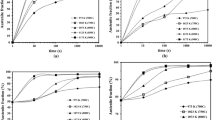Abstract
Metallography, electron microscopy, and X-ray diffraction are used to study the effect of preliminary plastic deformation in the friction-contact zone on the structural transformations and wear resistance of 12Cr19N9T austenitic stainless steel subjected to subsequent oxidation in air at temperatures of 300–800°C for 1 h. Severe deformation under dry sliding friction produces a two-phase (γ + α) nanocrystalline structure in a ~10-μm-thick surface layer of the steel. The microhardness is 5.2 GPa. Subsequent oxidation at 300–500°C causes an additional increase in the microhardness of the deformed surface layer of steel to the value of 7.0 GPa. This is due to the active saturation of austenite and deformation-induced α'-martensite with oxygen atoms, which rapidly diffuse deep into the metal along the grain boundaries. The oxygen concentration in the surface layer and steel wear products reaches 8.5 wt %. The atoms of the dissolved oxygen efficiently pin dislocations in the γ- and α' phases, increasing the strength and wear resistance of the surface of the 12Cr19N9T steel. Oxidation at 550–800°C results in the formation of a large number of Fe3O4 (magnetite) nanoparticles, which increase the resistance of the steel to thermal softening and its wear resistance.







Similar content being viewed by others
REFERENCES
L. G. Korshunov, A. V. Makarov, and N. L. Chernenko, in Development of Ideas of Academician V. D. Sadovskii. Collected Works (IFM UrO RAN, Ekaterinburg, 2008), p. 218 [in Russian].
L. G. Korshunov, V. A. Shabashov, N. L. Chernenko, and V. P. Pilyugin, Met. Sci. Heat Treat. 50, 583 (2008).
R. Z. Valiev and I. V. Aleksandrov, Nanostructured Materials Obtained by Severe Plastic Deformation (Logos, Moscow, 2000) [in Russian].
R. Z. Valiev and O. A. Kaibyshev, Grain Boundaries and Properties of Metals (Metallurgiya, Moscow, 1987) [in Russian].
M. Shafiei and A. T. Alpas, Metall. Mater. Trans. A 38 (7), 1621 (2007).
E. Metin and O. T. Inal, Metall. Mater. Trans. A 20, 1819 (1989).
L. G. Korshunov, V. G. Pushin, and N. L. Chernenko, Phys. Met. Metallogr. 113, 629 (2012).
L. G. Korshunov and N. L. Chernenko, Phys. Met. Metallogr. 114, 789 (2013). https://doi.org/10.7868/S0015323013070061
L. G. Korshunov and N. L. Chernenko, Phys. Met. Metallogr. 115, 1027 (2014). https://doi.org/10.7868/S001532301410009X
L. G. Korshunov and N. L. Chernenko, Phys. Met. Metallogr. 116, 512 (2015). https://doi.org/10.7868/S0015323015050095
L. G. Korshunov, N. L. Chernenko, I. G. Brodova and I. G. Shirinkina, Phys. Met. Metallogr. 118, 1113 (2017). https://doi.org/10.17804/2410-9908.2017.3.006-014
P. N. Belkin, A. M. Borisov, and S. A. Kusmanov, J. Surf. Invest.: X-ray, Synchrotron Neutron Tech. 10, 516 (2016). https://doi.org/10.1134/S1027451016030058
L. I. Mirkin, Handbook on X-ray Diffraction Analysis of Polycrystalline Materials (Fizmatlit, Moscow, 1961; Plenum, New York, 1964).
F. F. Khimushin, Stainless Steels (Metallurgiya, Moscow, 1967) [in Russian].
V. V. Sagaradze and A. I. Uvarov, Strengthening and Properties of Austenitic Steels (Red.-Izdat. Otd. Ural. Otd. Ross. Akad. Nauk, Ekaterinburg, 2013) [in Russian].
R. W. Hertzberg, Deformation and Fracture Mechanics of Engineering Materials (Wiley, New York, 1996, 4th ed.; Metallurgiya, Moscow, 1989).
A Handbook for Chemists (Khimiya, Moscow, 1968), 2nd ed., Vol. 5 [in Russian].
F. P. Bowden and D. Tabor, The Friction and Lubrication of Solids (Clarendon Press, Oxford, 1964; Mashinostroenie, Moscow, 1968).
ACKNOWLEDGMENTS
Electron microscopy was carried out at the department of electron microscopy of CCU “Testing center of nanotechnologies and prospective materials” of IMP UrBr RAS.
Funding
This work was carried out within the scope of state task “Structure” no. АААА-А18-118020190116-6 and Complex program of UrBr RAS no. 18-10-2-39.
Author information
Authors and Affiliations
Corresponding authors
Additional information
Translated by A. Bannov
Rights and permissions
About this article
Cite this article
Korshunov, L.G., Chernenko, N.L. Structural Transformations and Tribological Effects in the Surface Layer of Austenitic Chrome-Nickel Steel Initiated by Nanostructuring and Oxidation. J. Surf. Investig. 14, 632–638 (2020). https://doi.org/10.1134/S1027451020030301
Received:
Revised:
Accepted:
Published:
Issue Date:
DOI: https://doi.org/10.1134/S1027451020030301




